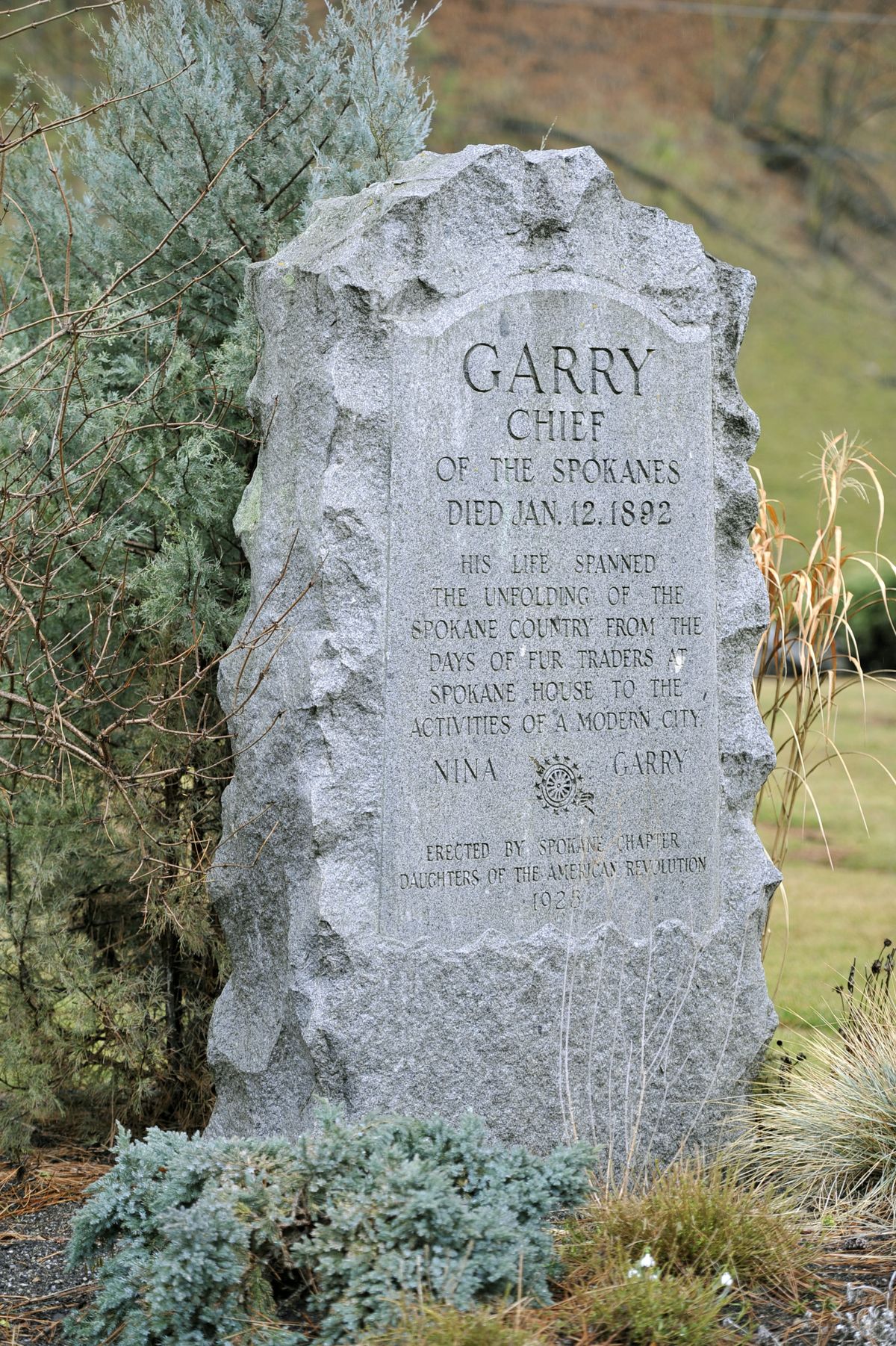Landmarks: Many sites honor Spokane Garry

There are a number of landmarks around town honoring the legacy of Spokane Garry, the storied leader in the Spokane Tribe of Indians who is also considered the region’s first educator.
Interestingly, the man himself was laid to rest in a pauper’s grave, and it was the activities of a few citizens and a chapter of the Daughters of the American Revolution that provided a more appropriate burial site and a landmark-worthy headstone.
Spokane Garry (also called Spokan Garry or Chief Garry, though he was not formally named chief of the tribe) was born around 1811, the son of Illum Spokanee, chief of the Middle and Upper Bands of the Spokanes. When the boy, whose original name is not known, was about 14, he was sent by his father to the Red River Missionary School in Ontario, Canada, in an agreement with the Hudson’s Bay Co., which was interested in giving Native American youth Western-style educations and then returning them to their homes to spread Christianity and other things they learned. It was at the school that the boy received the name Spokane Garry, apparently in honor of his tribe and Nicholas Garry, a director of the Hudson’s Bay Co.
Spokane Garry did return home in 1830, having learned math, agriculture, French and English and been converted to Christianity. He tried sharing his knowledge and set up a schoolhouse in the 1830s at what is now known as Drumheller Springs in Spokane, which garnered him the title of first schoolteacher in Spokane.
Because of his language abilities, he became a negotiator, interpreter and messenger for his tribe. Throughout his life, he advocated peace and was a staunch proponent of fair land settlements for his tribe. During the wars of 1858 between various tribes in the area and U.S. soldiers, Spokane Garry continued to urge peaceful solutions, to his own detriment. He lost stature among his tribe not only because he was unable to prevent attacks by the soldiers, but he refused to join in the fighting once it started.
But he was no pushover. Gen. O.O. Howard wrote of Spokane Garry that he spoke like a lawyer and “knew how to filibuster like a congressman.” When threats came in 1877 to move the Spokanes to a reservation west of the Columbia River, Spokane Garry said: “What right do you have to dictate to us? This is our country and we will not leave it.” And when a reservation was created in 1881 near where the Spokane River joins the Columbia, Garry stated he would never go there. “I will die first,” he said.
He lived on a little farm in what is now Hillyard, but in 1888 when he was away fishing for a few days, a white settler took it over. Although he tried through the courts to get it back, he was unable to, and he and his small band moved to Latah Creek just west of town, finally settling at Indian Canyon, where he died on Jan. 12, 1892.
He was buried in a pauper’s grave at Greenwood Memorial Terrace with only a small wooden cross as a marker.
In 1922 a chapter of the Daughters of the American Revolution formed, originally calling itself the Spokane Chapter. As most chapters take a name honoring a person from American history, it appears from the minutes of the group that they sought to register their chapter as the Spokane Garry Chapter of the DAR, a process they completed in September 1928.
In 1925 they set themselves to the task of better recognizing Spokane Garry. Pat Ewers and Maellen Ford of the chapter have gone through records and recreated the events of that time. A man identified as Judge Turner offered to put up $45 to purchase two spaces at Greenwood at a prominent location just inside the east gate to the cemetery, the chapter’s minutes show. Records also detail how members paid off the purchase through assorted activities, including taking magazine subscriptions. And a man identified as W.D. Vincent offered to put up an appropriate marker, which turned out to be a column created from Medical Lake granite. Arrangements were made to move Spokane Garry’s remains to the new location.
This was all done in just a few months, beginning in February 1925 and concluding with the June 13 dedication ceremony, which attracted Spokane Garry’s descendants, members of the tribe and leading citizens of Spokane – as well as news coverage. Later, in 1962, the chapter arranged to have the remains of Spokane Garry’s wife, Nina, who had been buried near Fairfield, laid next to him in the cemetery. They also placed a marker and flagpole at Drumheller Springs, where Spokane Garry’s school had been located.
Of course, since his death, Spokane Garry has had a city park and a school named for him. The Cathedral of St. John the Evangelist has a stained glass window depicting his baptism, a street at the Mukogawa Fort Wright Institute bears his name, a bronze plaque on Canada Island in Riverfront Park is a tribute to him, and his bust is on the wall of The Spokesman-Review’s production building on Monroe Street in downtown Spokane.
And as for his final place of rest, many people stop by his grave marker as they enter the cemetery. How nice that they can pay honor to Spokane Garry, a boy whose true name is lost in history but who grew to be a man of significance to his tribe and to the region’s history.